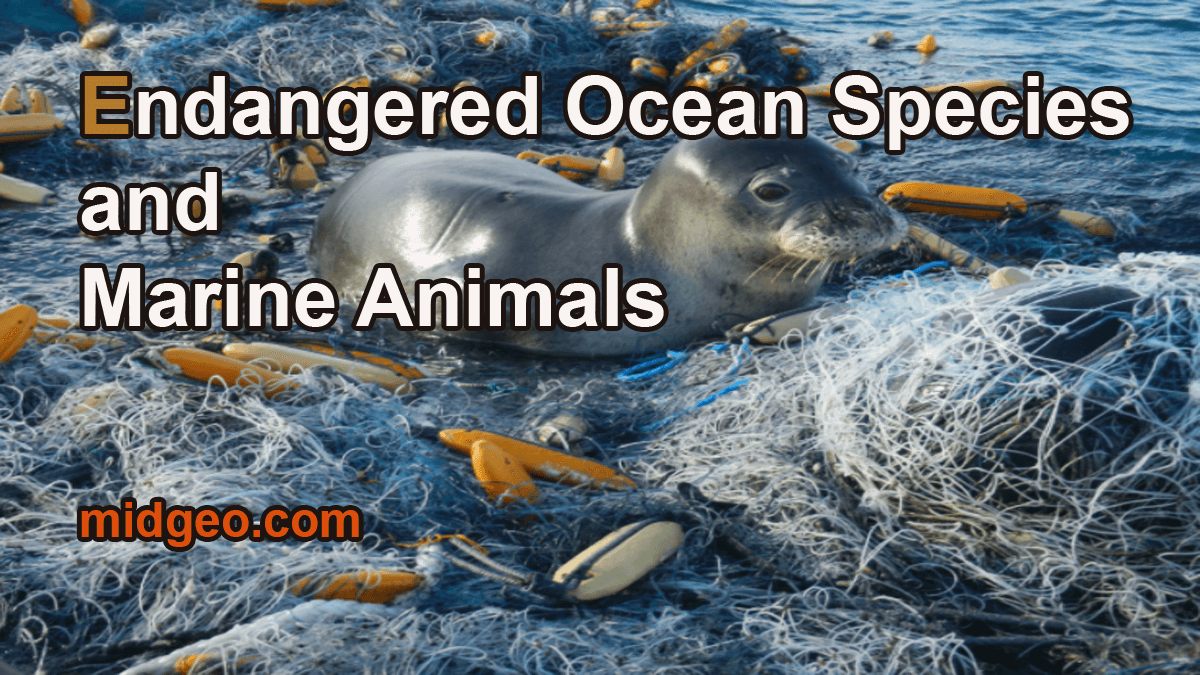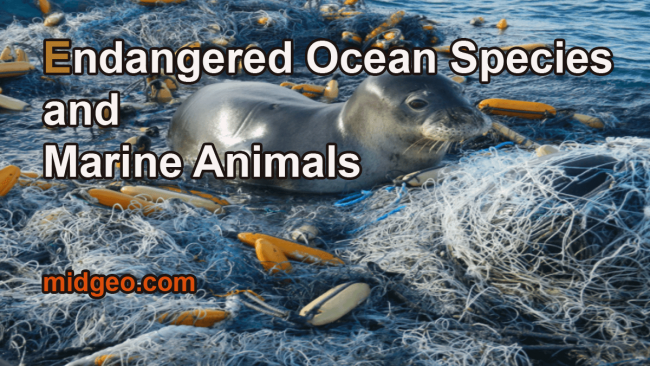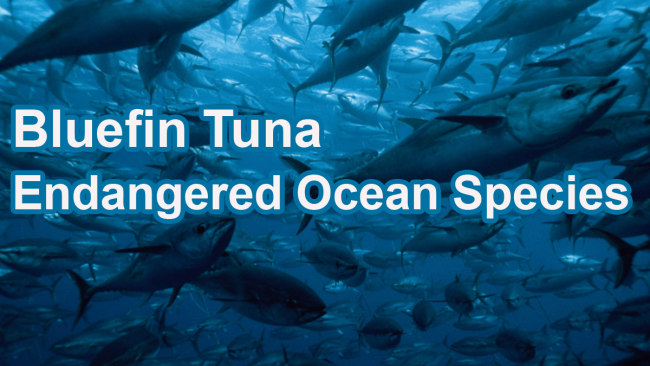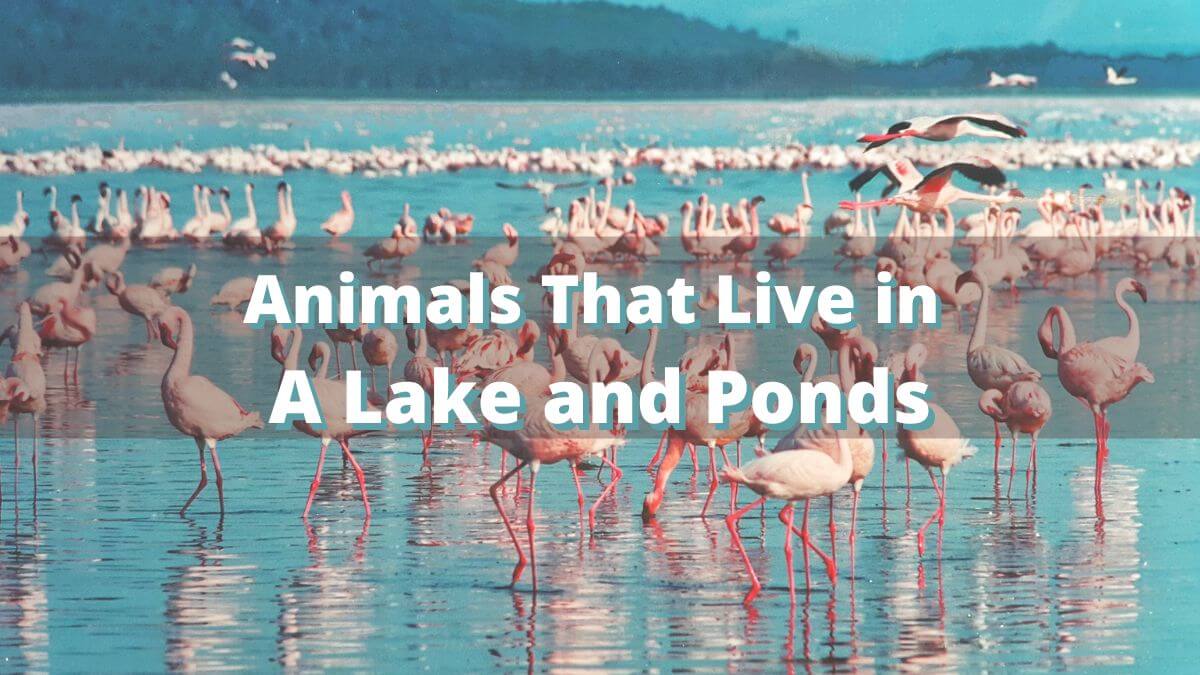17 Most Endangered Ocean Species and Marine Animals

The earth presently is facing an sixth mass extinction of plant species. The second wave of extinction has occurred in the history of half a billion years. The conditions are nearly as severe as they were 65 million years ago when dinosaurs ceased existence. No one will blame others except for our human fate.
Now a days it’s a common topics Endangered Ocean Species and Marine Animals. Let me explain.
We have mistreated the environment in accordance with our needs and were unaware of the consequences.
We dump our toxic waste out of our factories and homes on water bodies. This has made the marine ecosystem the most affected and it is no surprise that so many animals and become other endangered ocean species too.
Right!

Hey! Geo lover, This article discusses Most Endangered Ocean Species and Marine Animals that is in a critically endangered state.
Endangered Ocean Species
Content Summery
Today, many marine species are listed as endangered around the globe. Now People are very worried that too many marine animals were being taken.
We started to question “are animals endangered?”. It’s can be taking a long time to completely save Ocean Species and Marine Animals. But thankfully, a lot of people are working together to make this a reality.
Marine Animals is suffering with the effects of climate change, habitat loss, pollution, overfishing, and other factors.
Ocean Species is quickly vanishing due to human activity. An estimated 19,000 sea animals are killed per hour, with the current extinction rate being 100 times faster than what the Earth can sustain. For every species lost, there are many that are still thriving, but these species are on the brink of extinction as well.

Endangered Ocean species data is notoriously scarce, so where do you start?
This blog post offers a cool list of 17 of the world’s most endangered marine species and where you can see them.
Discover 17 of the world’s most endangered marine species and where to see them
1. Green sea turtle (Chelonia mydas)
The green turtle is an example of the largest marine turtle and the only one that is a herbivore. The tint of their cartilage and shortening gives green turtles their name, not their shells. The local population in the Eastern Pacific refers to a combination of green turtles with darker shells as “black turtles.”
Green turtles are found in the *Atlantic, *Pacific, and *Indian oceans. We can find green turtles in inshore and near-shore seas from Texas to Maine, the US Virgin Islands, and Puerto Rico in the Atlantic and Gulf of Mexico.
Most Endangered Ocean Species (Green sea turtle) mid geo
Commercial egg and food harvesting pose the greatest threat. Small turtles are sometimes stuffed for curios while other green turtle components are used for leather. Recently, Accidental catch in commercial shrimp trawling is becoming a more common cause of death.
2. Ganges River Dolphin (Platanista gangetica)
Dolphins are endangered ocean species all across the world, primarily due to human-caused threats. Complexity in fishing gear and nets, as well as pollution, are two of the most serious challenges.
Dolphins frequently follow the same fish species as commercial fishing ships and may become entangled in their nets. The Ganges river dolphin, Platanista gangetica (Roxburgh, 1801), is a freshwater dolphin species found in the Ganges-Brahmaputra-Meghna river basins of India, Bangladesh, and Nepal. It is also known as “shusuk” in Bangla.
3. Hawksbill sea turtle (Eretmochelys imbricatus)
Unintentional catch of sea turtles in fishing gear is a major threat, as it can result in drowning or injuries that lead to death or debilitation. Bycatch of sea turtles is a global issue.
Loss of nesting habitat and coral reefs owing to coastal development, rising seas from climate change, and pollution are all important threats to hawksbill turtles. Rising sea levels and more violent storms are causing nest inundation and degradation of nesting beach habitat.
According to new findings, global climate change is harming coral reefs by increasing the number of cases of coral diseases, which can eventually kill entire coral reef communities. These coral reefs provide food and habitat for Hawksbill turtles.
Non-native and native predators destroy and consume eggs and hatchlings, posing a serious threat to sea turtles all over the world. Feral and semi-domesticated dogs, in particular, have accompanied the growth of human coastal communities, resulting in widespread ingestion of hawksbill eggs and hatchlings over the world.
Endangered Ocean Species and Marine Animals ( Hawksbill sea turtle )
All sea turtles are threatened by increasing pollution of nearshore and offshore marine ecosystems, which impairs their habitats. Hawksbill turtles eat human-discarded marine trash such as fishing lines, balloons, plastic bags, floating tar or oil, and other items they mistake for food.
They can also become entangled in maritime debris, such as lost or discarded fishing gear, and die or suffer major injuries as a result.
4. Hammerhead Shark (Sphyrna mokarran)
Hammerhead sharks can be found in warmer seas along coastlines and continental shelves all over the world. Unlike other sharks, some hammerheads prefer to swim in groups during the day and then hunt alone at night. Some of these classes are found at Colombia’s Malpelo Island, Ecuador’s Galápagos Islands, Costa Rica’s Cocos Island, Hawaii’s Molokai, and off the coasts of southern and eastern Africa.
Shark meat has grown dramatically in recent years, and shark goods such as cartilage and oil all contribute to a market worth over $1 billion each year. All the major fishing countries engage in harmful fishing techniques that kill up to 100 million sharks each year, contributing significantly to the global drop in shark populations of 70% over the last 50 years that become listed Hammerhead Shark endangered ocean species.
5. Giant Devil Ray (Mobula mobular)
Devil Ray is most commonly found in the Mediterranean Sea, although they can also be found in the Eastern Atlantic Ocean, particularly off the southwest coast of Ireland and south of Portugal, as well as the northwest Atlantic.
The species has been found in a variety of Mediterranean countries, including Croatia, Greece, Italy, and Turkey, indicating that it has a broad range. Deep water is where they prefer to be.
The devil Ray has a small range and a slow reproduction rate. As a result, it is sensitive to changes in the environment. Its population is on the decline.
Fishing, resource exploitation, industrial rubbish, and solid waste are just a few of the hazards facing the big devil ray. Pollution in the Mediterranean and bycatch capture in various fishing equipment, such as trawls, tuna traps, and dragnets used for swordfish, are the greatest threats to this species.
Mid Geo
The devilfish was designated as a vulnerable species by the IUCN Red List in 2004. Due to limited population resilience and severe bycatch mortality, it was listed as endangered ocean species in 2006
6. The Kemp Ridley Sea Turtle (Lepidochelys kempli)
They are mostly found in the Gulf of Mexico, but some have been spotted in the Atlantic Ocean and the eastern North Atlantic.
The Gulf of Mexico once had tens of thousands of female Kemp’s ridleys nesting at Rancho Nuevo, Mexico. Kemp’s ridleys have been recorded as endangered under the Endangered Species since 1970 and are critically endangered ocean species globally.
Click To Read More
They are the most critically endangered ocean species of all sea turtle species. Accidental capture in fishing gear such as shrimp trawls, gill nets, longlines, traps, and dredges remains the biggest threat to the Kemp’s ridley, in addition to threatened nesting habitat.
Prior to the Gulf oil spill, efforts to rebuild sea turtle numbers resulted in partial recovery.
7. Galápago Penguin (Spheniscus mendiculus)
Galapagos penguins are the world’s rarest and most endangered penguin species, as well as the only penguins that can be found near the equator.
During the 1982-83 and 1997-98 El Nio occurrences, the population was drastically reduced, with a 60 percent drop in population. On the IUCN Red List of Threatened Species, the Galapagos penguin is classified as Endangered.
Pollution, bycatch, and climate change are all threats to penguins. Introduced species, such as dogs, bring diseases that can infect penguins, while cats offer a predatory threat to penguins.
Strong El Nio episodes in the past have resulted in up to 77 percent mortality, as well as substantial decreases in prey species and poor breeding success.
8. Florida manatee ( Trichechus manatus )
The Florida manatee is found solely in the coastal and interior seas of the southeastern United States, where it is the species’ northernmost range. Manatees are confined to the southern two-thirds of the Florida Peninsula in the winter because prolonged exposure to water temperatures below 18°C (65°F) can be fatal.
Florida manatees disperse around the state and into adjacent states as water temperatures rise in the spring and summer.
So, what has caused the endangered ocean species of manatees? The loss of habitat and collisions with boats and ships are the two most serious risks. Natural nesting places are being eliminated as new developments are erected around waterways. Algal blooms are caused by sewage, manure, and fertilizer run-off into the water.
Click to Read More Mid Geo
9. Hector’s Dolphin (Cephalorhynchus hector)
Hector’s dolphins are New Zealand’s coastal dolphins. Mui dolphins are currently only seen between Maunganui Bluff and Whanganui on the northwest coast of the North Island. The South Island is located on the island of New Zealand. Hector’s dolphins can be found in the South Island’s waters, and there are at least three genetically diverse regional populations.
Hector’s dolphins are usually found within 20 nautical miles of the coast, in water that is less than 328 feet deep.
Set-netting continues to kill dolphins off the coast of New Zealand.
Bycatch in commercial and recreational gill nets and trawls is the most serious hazard to both subspecies. Threats to the dolphins’ habitat, sickness, and tourism could all have a negative influence. Over time, fishing regulations and other management initiatives have become more stringent.
10. Hawaiian Monk Seal (Monachus schauislandi)
For many years, a lack of food intake by juvenile seals was a major contributor in the population reduction in the Northwestern Hawaiian Islands. Food scarcity may be exacerbated by changes in ecosystem productivity brought on by global climate change.
Hawaiian monk seals have one of the highest known rates of entanglement of any pinniped species, with pups and juveniles being the most entangled. Marine debris and abandoned fishing gear are two types of pollution that have a long-term impact on monk seal habitat, especially in the Northwestern Hawaiian Islands.
.
The Northwestern Hawaiian Islands, which are largely low-lying atolls prone to storm erosion and sea-level rise, face a severe loss of terrestrial habitat.
Toxoplasmosis, a prominent cause of seal death in the main Hawaiian Islands, is one of the principal illnesses of concern for Hawaiian monk seals. Toxoplasmosis affects females more than males, implying that the disease has direct consequences for the species’ reproductive capability and population expansion.
For the primary Hawaiian Islands population, intentional feeding, disturbance of sleeping or resting seals, boat or vehicle hits, and other direct human contacts, such as swimming with immature seals, have become a severe concern. Human-seal interactions are dangerous to both humans and seals, and in some circumstances, “conditioned” seals have had to be relocated to remote regions.
Hawaiian Monk Seal – Endangered Ocean Species and Marine Animals
11. Steller Sea Lion (Eumetopias jubatus)
The Steller sea lion is the world’s largest sea lion, measuring as much as a Volkswagen Beetle. Steller sea lions, which may grow to be ten feet long and weigh up to a ton, require an enormous amount of food to survive. As a result, they are “opportunistic feeders,” meaning they will consume anything is available.
Boat/ship collisions, contaminants, habitat deterioration, and illegal hunting are the most serious hazards to these creatures.
From Russia’s Kuril Islands in the Sea of Okhotsk through the Gulf of Alaska in the north, down to Ao Nuevo Island off the coast of central California in the south, the Steller sea lion can be found.
Steller sea lions tend to shift their range southward in the summer. In the winter and spring, multiple continuous haul-out sites may be identified across Hokkaido, despite the fact that there are no reproductive rookeries in Japan. Vagrants have been seen in the Yellow Sea and Bohai Gulf, as well as along the Korean and Chinese coasts.
12. Bluefin Tuna (Thunnus thynnus)
Endangered Ocean Species Overfishing and illegal fishing have decimated bluefin tuna stocks in recent decades.
The demand for this fish in high-end sushi markets has mostly caused the population to decrease.

The largest tuna, the bluefin, can live up to 40 years. They can dive to depths of over 3,000 feet and travel across all oceans. Bluefin tuna are divided into three species:
*Atlantic bluefin tuna (biggest and most endangered)
Bluefin Tuna – Endangered Ocean Species and Marine Animals MidGeo
*Pacific bluefin tuna, and
*Southern bluefin tuna
13. Fin whale (Balaenoptera physalus)
Fin whales can be found in all major oceans’ deep, offshore seas, primarily in moderate to polar latitudes. In the tropics, they are less common.
They can be found all year in a variety of settings, but the density of individuals in any area varies according to the season.
In the summer, they move from the Arctic and Antarctic feeding grounds to tropical breeding and calving grounds in the winter. It is unknown where the winter breeding sites are located. Fin whales roam in the wide oceans, far from the coast, making tracking them difficult.
Fin Whale – Endangered Marine Animals
Fin whales in the North Atlantic were hunted for oil, meat, and baleen until the last century, and are now classed as endangered.
Fin whales are threatened by environmental changes such as habitat loss, toxic chemicals, and climate change. Fin whales are still threatened by commercial whaling.
14. Hawaiian Monk Seal (Neomonachus schauinslaug)
Hawaiian monk seals can be found across the Hawaiian archipelago, including the main and Northwestern Hawaiian Islands, as well as in Johnston Atoll, about 1,000 miles southwest of Hawai’i.
The Hawaiian monk seal is a critically endangered marine animal that is only found in the Hawaiian Islands and is indigenous to them.
Unfortunately, there have been numerous instances of human brutality and fatal attacks on monk seals.
Monk seals are vulnerable to pets, particularly dogs. When in the vicinity of monk seals, please keep them on a leash to prevent damage or disease transfer to both the seals and the pets.
Hookings on fishing gear and entrapment in fishing nets are two examples of monk seal interactions that can result in damage or death. For additional information on how to avoid seal contacts, consult NOAA’s fisheries interactions guidelines.
Unfortunately, there have been numerous instances of human brutality and fatal attacks on monk seals.
The Hawaiian monk seal is susceptible to a number of diseases that could result in mass extinction. Toxoplasmosis and Leptospirosis have killed a number of Hawaiian monk seals in recent years, and viruses in the morbillivirus family are also a serious threat to our species.
Endangered Ocean Species and Marine Animals
Changes in monk seal habitat, or destruction to it, are adding to the species’ plight.
Coastal development and sea-level rise are among the challenges to monk seal habitat, which are diminishing the crucial habitat regions needed for rest and pupping activities.
Because these seals spend over a third of their time on land, it’s vital to protect beaches and other coastal places where they may rest. In addition, Toxoplasma gondii and Leptospira spp. can spread by inland water runoff.
15. Whale sharks (Rhincodon Typus)
Whale sharks can be found in the oceans of over 100 countries, however they are most commonly found in warm and tropical temperate seas between 30°N and 35°S.
In both marine and coastal environments, they like surface seawater temperatures of 21 – 25°C (69 – 77°F). They frequently concentrate in regions where they can eat, which might result in a lengthy journey.
The most serious hazard to whale sharks is habitat loss or degradation, which occur as a result of overfishing, coastal development, land-based pollution, increasing boat traffic, and noise pollution. Whale sharks are also threatened by commercial fishing for meat and fins, harassment, and boat strikes.
They are classified as endangered by the IUCN Red List because their number is declining.
Climate change has had an influence on many species around the world, including whale sharks. Climate change is causing a decline in their prey species, and coastal expansion is causing marine pollution, which is destroying significant areas of their habitat.
- World Whale Day 2024: Celebrating These Magnificent Creatures
- Celebrating National Polar Bear Day 2024: Raising Awareness for the Arctic Icon
- What is the Cutest Deep Sea Creature?
- Red Parrot Fish Information For First
- Most Endangered Marine Animals Due To Plastic Pollution
16. Blue Whale (Balaenoptera musculus)
They’re also found around Jan Mayen and Svalbard, as well as along Norway’s and Europe’s coasts. In the western Atlantic, they are quite rare.
The blue whale may be found in all of the world’s oceans. Blue whales are most commonly seen in the North Atlantic around the west and north Iceland. Aside from reports from Iceland and the Azores, sightings in the North Atlantic region are uncommon. Blue whales can be found as far north as Baffin Bay and as far east as Spitsbergen.
They’re also found around Jan Mayen and Svalbard, as well as along Norway’s and Europe’s coasts. In the western Atlantic, they are quite rare.
Blue whales, like other great whales, are threatened by environmental changes such as habitat loss and toxics. Although commercial whaling is no longer a concern, blue whales are particularly vulnerable due to climate change and its impact on krill their main diet.
17. Sea Otter (Enhydra lutris)
The key reasons for listing were a reduction in range and population size, vulnerability to oil spills, and the potential of oil flows from coastal tanker traffic.
We classified southern sea otters as depleted under the Marine Mammal Protection Act because of their threatened status.
Sea otters are a highly endangered ocean mammal speces. They are at significant risk of extinction due to many reasons, such as habitat, degradation, fishing nets, fur trade, oil spills, shark attacks, disease, and being viewed as competition.
However,
Please do not encourage the derangement of nature by spending hours scouring high-level datasheets. But if nature is your obsession, find out endangered ocean species and start looking for them now.
Some of these animals are small, living in the deep sea, hidden in the ocean floor. Others are shy and live alone, feeding on algae and benthic animals. Some are large and have beautiful colors, some are widely distributed, and some are incredibly rare.
Thanks for be with me. If you want to know more about “Endangered Ocean Species and Marine Animals” feel free comment me in the description box.




